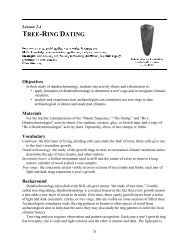Download pdf version - 42.3 MB - Research Laboratories of ...
Download pdf version - 42.3 MB - Research Laboratories of ...
Download pdf version - 42.3 MB - Research Laboratories of ...
You also want an ePaper? Increase the reach of your titles
YUMPU automatically turns print PDFs into web optimized ePapers that Google loves.
through 1875—would have been an era <strong>of</strong> free and open sales and consumption. These werethe same years in which the “Poor House” fell into ruin.Of the ale bottle fragments recovered from intact contexts, the bulk were found inLevel 2 in the southern half <strong>of</strong> the site (Table 7). The dating and spatial distribution indicatethat most <strong>of</strong> the ale bottles belong to the period <strong>of</strong> the “Poor House” or after, but probablybefore the era <strong>of</strong> the RobersonHotel/Central Hotel (1882–1911).Other stoneware vessels in the Kitchen group include jars (Figure 38b, d), jugs(Figures 38a–b and 39), and pitchers. All but one vessel appear to date from the early to midnineteenthcentury. Stoneware was first produced in North Carolina in the second quarter <strong>of</strong>the nineteenth century (Zug 1985:24). At least two <strong>of</strong> the jugs were incised, which is adecorative style that disappeared after the 1840s (Zug 1985:28–29). There was one machinemade,jiggered stacker jug, circa 1890s. Virtually all but the stacker jug were salt-glazed andwere for the most part produced locally in the eastern North Carolina Piedmont. One bluepaintedjug was <strong>of</strong> a type manufactured in Virginia. Several <strong>of</strong> the vessels can be attributedon the basis <strong>of</strong> style to known nineteenth-century potters: the Fox family (Nicholas and sonsHimer and Daniel were in operation from the early nineteenth century until 1880s);Nathaniel Dixon (born 1827, died 1863); and Elijah K. M<strong>of</strong>fit (born 1836, died 1910) (Zug1986:435–447). The trading networks to distribute the work <strong>of</strong> these potters were wellestablishedby the 1830s.Guilford, Hillsborough, and Pittsboro were trading hubs for the east-west andnorth-south merchants and traders. A network <strong>of</strong> plank roads, also known asthe “farmers railroads,” was built throughout Alamance and Chatham countiesfrom the 1830s to 1850s. Construction <strong>of</strong> these roads was state-subsidizedand extended from western Chatham County to the market areas <strong>of</strong>Fayetteville and Wilmington [Carnes-McNaughton 1997:83–84].Jugs were used to contain all kinds <strong>of</strong> liquids, including whiskey, wine, beer, cider,vinegar, oil, and molasses (Zug 1986:302–303). Battle (1907:576) tells <strong>of</strong> an incident in the1840s when a wagon full <strong>of</strong> jugs <strong>of</strong> peach brandy encamped just outside the alcoholprohibition zone around town and sold to students.Jars and crocks were used extensively to store foods in the nineteenth century. Asstated above, they kept foods cool and preserved in the era before refrigeration (Zug1986:288). They held fruit preserves, butter, lard, cheeses, pickled vegetables, and saltedmeats (Zug 1986:296). Retailers, such as the general stores operated on Lot 11, sold much <strong>of</strong>their product in these containers (Polak 1997:101).Pitchers were a versatile vessel form that could be used for food storage (such asbuttermilk) and also for serving and washing (Zug 1986:328).The distribution <strong>of</strong> kitchen stoneware sherds from intact contexts shows that themajority <strong>of</strong> stoneware was found in Level 2 in the southern half <strong>of</strong> the site (Table 7).Annular ware sherds make up 2% (Table 3) <strong>of</strong> the total ceramic assemblage. This is adecorative style <strong>of</strong> contrasting colored banding which can be found on several different waretypes. The Pettigrew pottery assemblage consists <strong>of</strong> 13% Creamware, 27% Pearlware, and60% Whiteware (all non-vitreous earthenwares). These ware types succeed each othertemporally (with some overlapping) in the order listed, indicating that the bulk <strong>of</strong> this group34







